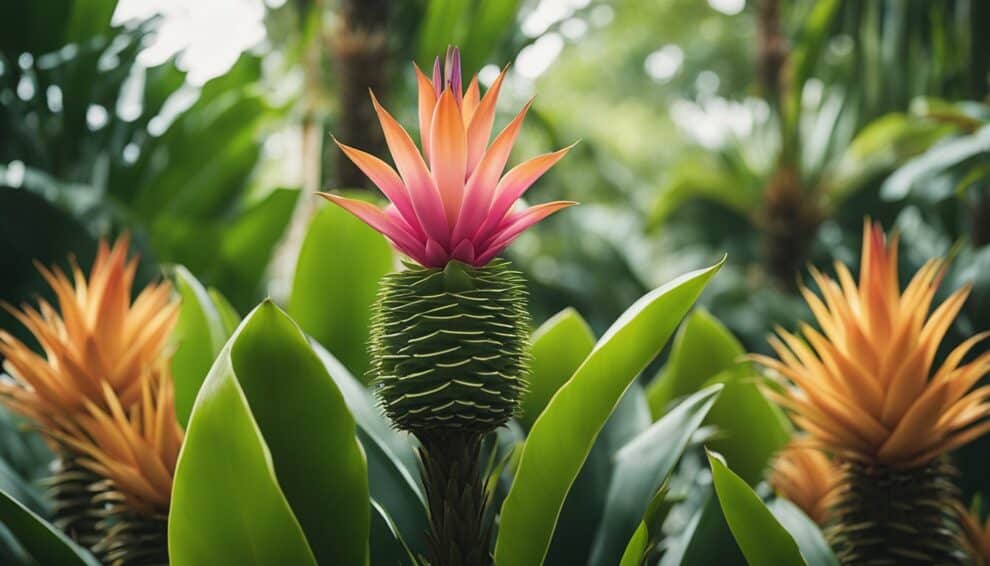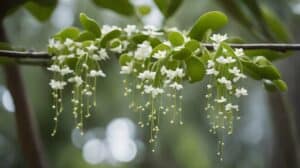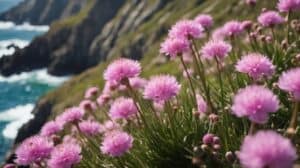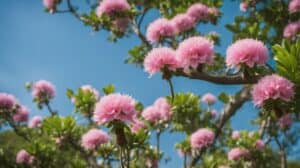Alcantarea Imperialis: A Giant Among Bromeliads

Alcantarea Imperialis is a magnificent plant that belongs to the Bromeliaceae family.
It is native to Brazil and is known for its impressive size and unique appearance.
The plant can grow up to 10 feet tall and 6 feet wide, making it one of the largest bromeliads in the world.
Its leaves are thick, leathery, and can reach up to 5 feet in length, forming a rosette shape that can hold water in its center.
The Alcantarea Imperialis is a popular choice among gardeners and plant enthusiasts due to its striking beauty and low maintenance requirements.
It is a hardy plant that can tolerate a range of temperatures and humidity levels, making it suitable for both indoor and outdoor cultivation.
The plant is also known for its ability to purify the air, making it a great addition to any living space or office.
In this article, we will delve deeper into the world of Alcantarea Imperialis and explore its unique features, growth requirements, and cultural significance.
We will also discuss the different ways in which this plant can be used for landscaping and decoration, as well as its potential health benefits.
Understanding Alcantarea Imperialis

Taxonomy and Classification
Alcantarea Imperialis is a species of bromeliad that belongs to the family Bromeliaceae.
It is native to Brazil and is commonly found in the Atlantic Forest biome.
The plant was first discovered in the 19th century by botanist Carl Friedrich Philipp von Martius.
The name Alcantarea is derived from the Portuguese surname Alcantara, while Imperialis refers to its impressive size and appearance.
The species is further classified into the genus Alcantarea, which is known for its large and showy bromeliads.
There are currently only 30 known species in this genus, with Alcantarea Imperialis being the largest and most impressive.
Physical Characteristics
Alcantarea Imperialis is a giant among bromeliads, with mature plants reaching heights of up to 2 meters and widths of up to 3 meters.
The plant has a rosette of leaves that grow up to 2 meters long and 20 centimeters wide.
The leaves are thick and leathery, with a glossy green color that can sometimes have a reddish tint.
The plant produces a large inflorescence that can reach up to 3 meters in height and is made up of numerous small, purple flowers.
The plant is known for its ability to adapt to a wide range of growing conditions, from full sun to partial shade.
It prefers well-draining soil and can tolerate periods of drought, making it a popular choice for gardens and landscaping projects.
Alcantarea Imperialis is also a popular choice for indoor cultivation, as it can thrive in a variety of potting mixes and growing conditions.
In conclusion, Alcantarea Imperialis is a stunning and impressive species of bromeliad that is sure to make a statement in any garden or indoor space.
Its unique physical characteristics and adaptability make it a popular choice for plant enthusiasts around the world.
Cultivation and Care
Growing Conditions
Alcantarea Imperialis is a tropical plant that thrives in warm and humid conditions.
It can be grown both indoors and outdoors, but it requires a lot of space due to its large size.
When growing Alcantarea Imperialis, it is important to provide it with the right growing conditions to ensure its health and vitality.
For optimal growth, the plant should be placed in a location that receives bright, indirect sunlight.
It is also important to keep the soil moist, but not waterlogged, as this can lead to root rot.
The plant should be watered regularly, but allow the soil to dry out slightly between waterings.
Propagation Methods
Alcantarea Imperialis can be propagated by division. This involves separating the plant into smaller sections and re-potting them.
To do this, carefully remove the plant from its pot and gently separate the root system into smaller sections.
Each section should have at least one healthy leaf and a portion of the root system. Re-pot the sections into fresh soil and water thoroughly.
Common Pests and Diseases
Alcantarea Imperialis is generally a hardy plant, but it can be susceptible to a few pests and diseases.
The most common pests that affect this plant are mealybugs and scale insects.
These pests can be controlled by wiping the leaves with a solution of soap and water, or by using an insecticidal soap.
Root rot is the most common disease that affects Alcantarea Imperialis. This can be caused by overwatering or poor drainage.
To prevent root rot, ensure that the soil is well-draining and that the plant is not sitting in water.
If root rot is detected, it is best to remove the affected parts of the plant and re-pot it in fresh soil.
Overall, with the right growing conditions and proper care, Alcantarea Imperialis can be a stunning addition to any indoor or outdoor space.
Design and Landscaping Uses

Alcantarea Imperialis is a versatile plant that can be used in a variety of landscaping designs.
Its large size and striking appearance make it an excellent focal point in any garden or landscape.
Here are some ways you can incorporate this giant bromeliad into your landscape design:
1. Container Planting
Alcantarea Imperialis can be grown in containers and placed on patios, decks, or other outdoor living spaces.
Its large size and unique appearance make it an excellent conversation piece.
When planting in containers, it is important to choose a pot that is large enough to accommodate the plant’s size and weight.
2. Poolside Planting
Alcantarea Imperialis is an excellent choice for poolside planting.
Its large size and tropical appearance complement the surrounding landscape and create a relaxing atmosphere.
When planting near a pool, it is important to choose a location that receives partial shade to protect the plant from excessive heat and sun exposure.
3. Landscaping Focal Point
Alcantarea Imperialis can be used as a focal point in any landscape design.
Its large size and unique appearance make it an excellent centerpiece for any garden or landscape.
When using Alcantarea Imperialis as a focal point, it is important to choose a location that is visible from multiple angles and provides enough space for the plant to grow.
4. Tropical Garden Planting
Alcantarea Imperialis is a popular choice for tropical garden planting.
Its large size and tropical appearance make it an excellent addition to any tropical garden.
When planting in a tropical garden, it is important to choose a location that receives partial shade and has well-draining soil.
Overall, Alcantarea Imperialis is a versatile plant that can be used in a variety of landscaping designs.
Its unique appearance and large size make it an excellent focal point in any garden or landscape.
Frequently Asked Questions

How do I properly care for an Alcantarea Imperialis?
Alcantarea Imperialis requires well-draining soil and regular watering. It is recommended to fertilize the plant every 3-4 months with a balanced fertilizer.
It is important to keep the plant away from direct sunlight, as it can cause leaf burn.
Additionally, it is recommended to remove any dead or damaged leaves to promote healthy growth.
What are the ideal lighting conditions for Alcantarea Imperialis?
Alcantarea Imperialis prefers bright, indirect light. It is important to keep the plant away from direct sunlight as it can cause leaf burn.
If the plant is not receiving enough light, it may become leggy and its leaves may lose their vibrant color.
Can Alcantarea Imperialis tolerate cold temperatures?
Alcantarea Imperialis prefers warm temperatures and does not tolerate frost.
It is recommended to keep the plant in an environment with temperatures between 60-85°F (15-29°C).
How often should I water my Alcantarea Imperialis?
Alcantarea Imperialis requires regular watering, but it is important not to overwater the plant.
The frequency of watering will depend on the plant’s environment and the season.
In general, it is recommended to water the plant every 7-10 days, allowing the soil to dry out between waterings.
What is the growth rate of Alcantarea Imperialis?
Alcantarea Imperialis is a slow-growing plant, and it can take several years to reach its full size.
The plant can grow up to 5 feet (1.5 meters) tall and 6 feet (1.8 meters) wide.
When and how should I repot my Alcantarea Imperialis?
Alcantarea Imperialis should be repotted every 2-3 years or when it outgrows its current pot.
It is recommended to use a well-draining soil mix and a pot that is slightly larger than the current one.
When repotting, it is important to be gentle with the plant’s roots to avoid damage.














